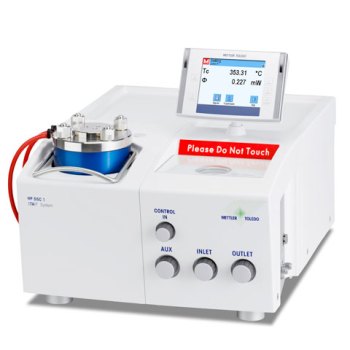by Jeffrey Justin K | Jun 17, 2013 | Product News

Increased pressure influences all physical changes and chemical reactions in which a change in volume occurs. For material testing, process development or quality control there is often no alternative to DSC measurements under pressure.
- Shorter analysis time – higher pressure and temperature accelerate reactions
- Measurements under process conditions – simulation of practical reaction environments
- Better interpretation – effects can be separated by suppressing vaporization
Innovative Technology
Features and Benefits of the HP DSC 1
| Shorter analysis time – higher pressure and temperature accelerate reactions |
 |
| Measurements under process conditions – simulation of practical reaction environments |
 |
| Better interpretation – effects can be separated by suppressing vaporization |
 |
| Suppresses and delays vaporization – separation of a reaction from overlapping vaporization |
 |
| Higher gas concentrations – reaction rate of heterogeneous reactions with gases is increased |
 |
| Measurements under special atmospheres – oxidative, oxygen-free conditions or measurements with toxic or combustible gases are possible |
 |
| Possibility of working at different pressures – more accurate measurement of adsorption and desorption behavior |
 |
Specifications – HP DSC 1 – High Pressure Differential Scanning Calorimeter
| Temperature range |
RT … 500 °C / 700 °C |
| Heating rate |
0.1…50 K/min |
| Pressure range |
0 … 10 MPa (overpressure) |
| Gas flow |
Freely selectable; accurate control of purge gas flow and total pressure with external controller |
| Atmospheres |
Measurements under different atmospheres: inert, oxidizing, reducing, reactive, e.g. nitrogen, oxygen, hydrogen, methyl bromide, ethylene, propylene, carbon dioxide, etc. There are certain restrictions for combustible and toxic gases |
| Material Number(s) |
51143145 |
| Trade Name |
DSC |
by Jeffrey Justin K | Jun 17, 2013 | Product News
by Jeffrey Justin K | Jun 14, 2013 | Product News
SANPLATEC ACRYLIC VACUUM GLOVEBOX VSC-800

Features
First commercialization in Japan of this type of all acryl.
Insertion and removal of work devices is performed at left side door. In addition, insertion and removal of material samples during work is performed through a right pass box. Strength is designed to withstand even a complete vacuum.
The VG-800 is equipped with a 100V tap as standard. Use it when using a power supply at the inside.
* There is a record of delivery of chamber 3 coupling and work use vacuum chamber. Designed and manufactured to meet your site needs.
(Option examples)
Installation of electrode terminal 2 pins, 4 pins, and 16 pins, Gas introduction opening (inside, outside), Modifi cation of valve outside diameter.
Specification
| Outside Dimentions |
1209W x 648D x 660H mm |
| Effective inner dimentions |
709W x 155D (Top) /370D (Bottom) x 450H mm |
| Pass box inside dimensions |
310W x 200D x 200H mm |
| Valve |
Chamber |
2 |
| Pass box |
2 |
| Glove port |
1 |
| Pump connection side |
2 |
| Vacuum gauges |
Main chamber, Pass box 1 each (for 0 to -0.1MPa) |
| Glove, glove with band |
1 set |
| Glove port door |
1 set (used at decompression) |
| Receptacle |
3P-2 serial taps |
| Weight |
Approx. 94kg |
* Nozzle of hose nipple type valve is 9mm.
Note : Both the body and pass box of this vacuum glove box are so designed to withstand a complete vacuum, but since sudden suction and inhalation causes damage and deterioration of life to speed up, perform them as slowly as possible.
When using as a vacuum desiccator, always use with the glove cap installed.
The vacuum gauge shows the atmospheric pressure and glove box interior pressure difference. (Units: MPa)
by Jeffrey Justin K | Jun 14, 2013 | Product News
SANPLATEC STERILE BOX (Normal Acrylic plate)

Features
Simple design standard sterilized box
Large opening makes for superior ease-of-use. Also, provided a lock to ensure work is secure.
Economical because you can select and mount the necessary parts.
Consult with us for use of the sterilizing lamp installation, sterilizing-resistant lamp specification plate.
Acrylic
| Code |
Model |
|
| 0186 |
ST-1 type |
|
| 0187 |
ST-2 type |
|
Specification
| Model |
ST-1 type |
ST-2 type |
| Outside Dimension (mm) |
650W x 475D x 530H |
930W x 575D x 530H |
| Effective inner dimension(mm) |
590W x 420D x 460H |
700W x 515D x 460H |
| Pass box |
 |
 |
| Pass box inside dimension(mm) |
|
170W x 190D x 190W |
| Weight |
Approx. 11kg |
Approx. 15kg |
| accessories |
One pair of gloves |
by Jeffrey Justin K | Jun 14, 2013 | Product News
Solves the problem of acrylic plate degradation caused by the sterilization lamp

Solves the problem of acrylic plate degradation caused by the sterilization lamp
The DX type has a device that constantly circulates dry, sterile air through an acrylic housing which can be installed with a Japan Pall Corporation-made HEPA capsule filter (dust collection efficiency: 99.97%, 0.3 µm), silica gel and activated carbon.(It is possible to sterilize the HEPA capsule with ethylene oxide gas.)
One unit can be used as a sterilized box and dry box.
Uses a sterilization-resistant lamp plate.
Big opening makes it secure to place and remove microscopes and other devices.
Door can be locked so work can progress with security.
| Code |
Model |
drawing |
| 0228 |
U-DX type |
(PDF) |
Specification
| Outside Dimension (mm) |
995W x 575D x 530H |
| Pass box Inner dimension(mm) |
170W x 190D x 190W |
| Weight |
Approx. 18kg |
| air circulating device |
one |
| gas cocks for filling |
2 pieces |
| sterilization lamp; fluorescent lamp |
one of each (per one unit), 10 W |
| outlet |
double-barreled built-in outlet |
| Fan |
50/60 Hz, 5/4 W |
| accessories |
One pair of gloves |
Use as a dry box
Normally, air that has been adequately dried using silica gel is circulated, but including the use of nitrogen gas is even more effective. (Always install a decompression valve on the gas tank for use.)1. Open the cock on the upper left-hand side of the main unit.2. Inject the gas to the cock on the upper right-hand side of the main unit using the diameters 6mm tube.3. This depends on the gas flow amount, gas will fill the inside in approximately three to five minutes, so close both gas stopper cocks on the tank.
Use as a sterile box
When using this under normal conditions, the sterilizing lamp is adequate. However, dry, sterilized air can be constantly circulated inside using an air filter device (removes more than 99.97% of the particles of 0.3 µm using the DOP test method) and silica gel (filled to approximately 80% of the silica gel tank).
1. Close the main unit door, and turn on the switches for the sterilizing lamp and fan.
2. When the sterilizing lamp is on, always mount the accessory shielding plate.
3. When using the pass box on the right of the main unit, open the outside door while the inside door is closed, and open the inside door after closing the outside door.
4. If the filter or silica gel is dirty, clogged or discolored, replace them.


